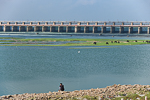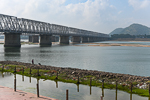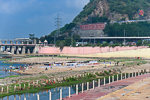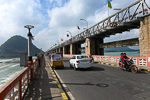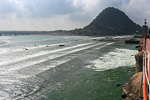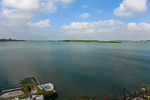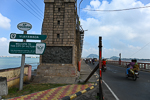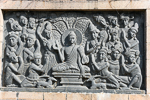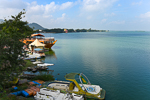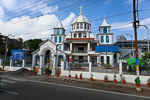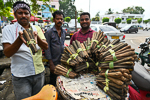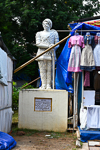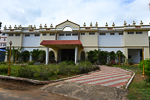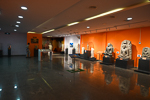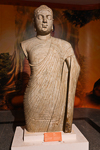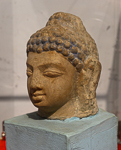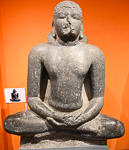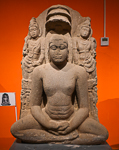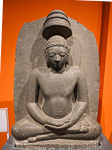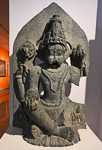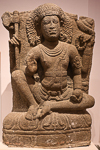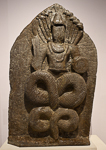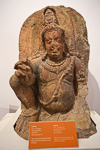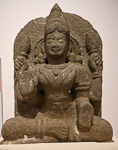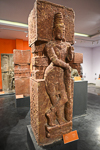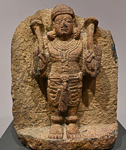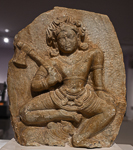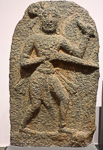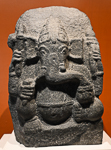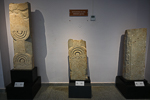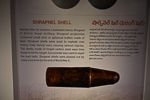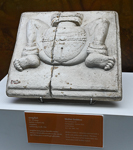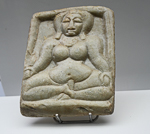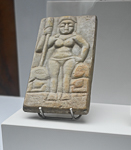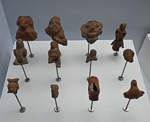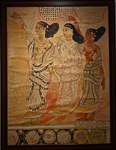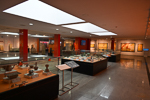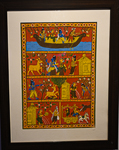Vijayawada, Andhra Pradesh, India (Dec 2022, Dec 2005)
Vijayawada, also called Bezwada, lies at the head of the delta of the mighty Krishna river. Surrounded by hills and intersected by canals, it has emerged as a major port and important junction on the east-coast train line from Kolkata to Chennai. While it's an important industrial center and a hectic city, many also regard it as the heart of Andhra culture and language. The main attraction here are the temples, including ancient rock-cave temples. The city is a centre for Hindu pilgrimages. [Adapted from Encyclopedia Britannica]
Krishna river and |
Railway bridges on the |
Dhobis along the river |
Bridge atop Prakasam |
Water being released |
The reservoir on the |
Other end of Prakasam |
The plaque on the |
The reservoir |
St. Peters Cathedral |
Roasted snack |
Medieval Andhra warrior |
Bapu Museum The Bapu Museum (formerly: Victoria Jubilee Museum) is an archaeological museum. It was renamed in the memory of the renowned film director, illustrator, cartoonist and author Bapu. The museum has a large collection of sculptures, paintings and artifacts of Buddhist and Hindu relics, with some of them as old as 2nd and 3rd Centuries. (source: Wikipedia) |
|||
Bapu museum |
Museum interior |
Buddhist sites in AP
|
Indra, 12 cent. CE |
Buddha, 3rd cent. CE |
Head of Buddha |
Buddha |
Vardhamana Mahaveera |
Vardhamana Mahaveera |
Vardhamana Mahaveera |
Yoga Narasimha, 12th c. |
Bhairava, 12th c. CE |
Veerabhadra, 12-13th c. CE |
Bhairava, 10-11th c. CE |
Naga Raja |
Kubera |
Lakshmi Devi, 14th c. CE |
Mantapa pillar |
Surya, 11th c. CE |
Chandiswara |
Hero stone, 13-14th c. CE |
Hero stones from |
Panavattam |
Ganesh, 11-12th c. CE |
Anjaneya, Lakshmana, |
Saptamatrikas, 12th c. CE |
Satavahana pillars |
Info panel on the art of |
Artifacts from the |
Artifacts from the |
Artifacts from the |
The origin of shrapnel |
Mother goddess, 1st c. CE |
Female deity, 3rd-4th c. CE |
Mahisasuramardini |
Terracotta figurines |
Parvathi w/ Companions |
Mohini with Attendants |
Upper storey of museum |
Ramayana story |
All photos below are from Dec 2005 |
|||
|
Busy intersection  |
City by the Krishna river  |
View from above (more)  |
Random street  |
Colored chicks (more)  |
Visitor to the city (more)  |
Visitor to the city (more)  |
Pilgrim boy  |
|
Kanak Durga temple  |
Pilgrims (more)  |
Pilgrims  |
Siblings  |
Pilgrims climbing steps  |
Sculpture on Shiva temple  |
Sculpture on Shiva temple  |
Father and son  |
|
Bathing pilgrims  |
Of all shapes and sizes  |
For both genders  |
Sacred water?  |
|
Ready for a dip  |
Father and son  |
Two brahmins  |
Pilgrim in black  |
Undavalli Caves ▒ |
|||
|
Hindu rock-cut cave temples  |
Begun in 6th century CE  |
Second of four floors (more)  |
Reclining Vishnu (more)  |
 |
Landscape from the caves  |
Landscape from the caves  |
Rishi  |
Designed in collaboration with Vitalect, Inc. All rights reserved. |









